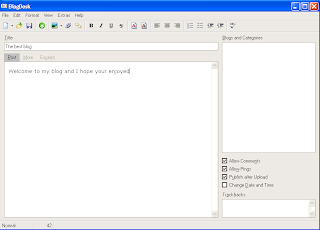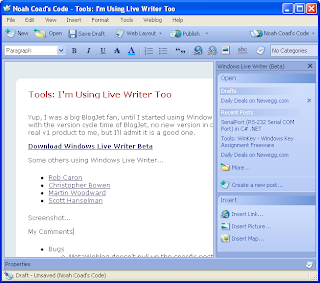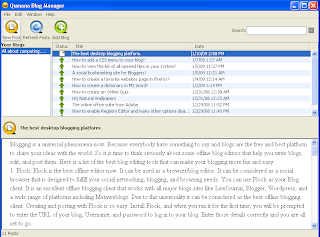
1. Flock: Flock is the best offline editor available now. It can be used as a browser/blog editor. It can be considered as a social browser that is designed to fulfill your social networking, blogging, and browsing needs. You can use Flock as your Blog client. It is an excellent offline blogging client that works with all major blogs sites like LiveJournal, Blogger, Wordpress, and a wide range of other platforms including Metaweblogs. Due to this universality it can be considered as the best offline blogging client. Creating and posting blogs with Flock is so easy. Install Flock, and when you run it for the first time, you will be prompted to enter the URL of your blog, User name, and password to log in to your blog. Enter those details correctly and you are all set to go.
A cool feature of Flock is the "Blog This" feature. If you see some interesting content or a photo, or anything else so interesting just right click on it and Select "Blog This" to instantly post it to your blog. There are a lot of cool features that Flock has and you can explore it to learn more about Flock.

BlogDesk: Another great offline blogging tool you can use and it is free. You can use this to easily post your blogs. But I think it is not as flexible as Flock. The striking features of this tool is that it has a good tag editor. You can add your tags to a list and whenever you want to add a tag to your posts, you can add it from the list. It has a spell checker! The spell checking is a useful feature. I think configuring it is a bit tough. To configure BlogDesk you have to select File> Manage Blog. There are two ways to upload images via BlogDesk. First you can directly upload images which is the easiest way and the second method is to use FTP protocol. You can edit your images within BlogDesk because it offers basic image editing features like cropping, rotating, and changing file formats etc. Some other features of note are that BlogDesk allows you to edit already posted blogs. Then it has a auto save feature which will automatically save your post in a folder locally so that you did not have to take a backup of your blogs.The only down side is that it did not support a lot of blog platforms. Actually I cannot find the name of Blogger in the supported blog list. But it definitely worth a try.

Live Writer: Live Writer is a cool blogging client from Microsoft. But installing it is a bit tricky for me. When I clicked on the install button I see a message that I have to upgrade my installer. So make sure you have updated your system with the latest Windows installer. A nice article to solve installation problems for Live Writer is available here. Liver Writer is free to use and offers a bunch of features to make your blogging more efficient. It is so easy to use Live Writer because it has a lot of nice features that makes your blogging easy. You can create posts exactly the way it looks in a web browser. This is because Live Writer will download a copy of the CSS style you are using in your blog and keep a local copy of it. The next feature that I noted is that it allows you to add maps to your post via Windows Live Local. Live Writer has an auto correct option and it also can automatically save your post as drafts. It allows tabbed blogging. That is you can create more than one blog at a time. Each post appears as a tab. The image editing features of Live Writer worth mentioning because it provide you with some basic image effects that is very helpful to add image effects to your images. You can also add videos, podcast etc to your blog. The only downside is that the preview is rendered exactly the way it looks in IE! The software is in its beta now. So it is not a completely stable version. Sometimes after this beta we will have to wait and see if it remains free or become commercial or become a part of Microsoft Office suite. So grab it now!

Qumana: A nice blogging tool you would use especially if you are a beginner and still learning how to post blogs using offline clients. It has a nice interface and so it is very easy to learn. Then it has all the features you expect from a blogging client. When you run it for the first time, it will prompt you for your blog address. Just type in your address, User name and password. Qumana will automatically configure everything for you. This is a feature that is of great help. Creating posts with Qumana is also easy. Another feature it possess is that it gives you the opportunity to monitonize your blog using QAds. You can sign up for QAds and insert ads in your posts. Then it has a blog manager which helps you to manage your posts quickly. In the Blog Manager window you can see the number of blog posts and you can preview, edit, publish, and republish posts. But it is a bit slow. It is a cross platform tool, that may be the reason. It is noticeably slow when you spell check your post. Above all it is one of the best blog editors I ever know.
w.blggar: It is a fantastic blogging tool that works well with Windows operating system. It is a good replacement for Live Writer! Because Live Writer is in beta there may be some stability issues, because Quamana is Cross Platform it has some problems running in Windows. So the tool that you have to watch out for is w.blggar. When you launch w.bloggar for the first time, the configuration window will appear where you have to select a platform and enter an alias for your blog. Then you have to enter User name and Password of your blog and press Finish button to complete the installation process.But creating posts is not easy for novices because w.bloggar did not have a WYSIWG feature. It instead has a text editor. It supports HTML syntax highlighting. Unfortunately it did not support tags. It also did not have an image editor. Truly not for novices. But it is quiet stable and almost never crashes. It also has good blog backup feature. It also has powerful FTP uploading features that definitely worth a mention. It supports a wide number of platforms. It is a tool apt for a pro-blogger.

Zoundry: Zoundry is another blog editor that you can give a try. It is one of the best blog editors both in case of usability and functionality. After you have properly configured Zoundry you can start creating your blog. I will mention quickly some of the features I like the most about Zoundry. It has an intelligent tag completion feature as you see in website design tools like Dreamweaver. So you will love using HTML scripts while creating posts with Zoundry. The auto complete list includes both XHTML and CSS keywords. It has Design, XHTML, and Preview modes. You can create multiple blog profiles in Zoundry. It also supports a large number of blogging platforms. It also offers good blog back up features. It is highly extensible with plug-in support. All you have to do is to visit Raven Zoundry site and download plug-ins you need. Then extract and copy them to your Zoudry installation folder. Then there is a blog profile manager and good tag support. Lot of cool features you can explore and find. Amazing tool that worth a try!

Do not want any of these tools just log in to your blog account and create post there. Alternatively, you can also use MS Word which support blog creation and posting. You can also use ScribFire which is a Firefox plug-in for blogging. It gives you the comfort of blogging inside Firefox. There are commercial alternatives also like BlogJet and ecto.
I hope you enjoyed the post!


0 comments:
Post a Comment